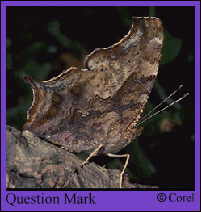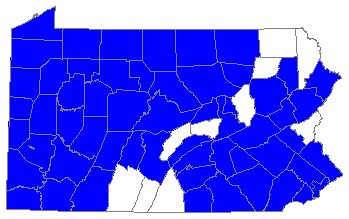 |
 

 |



Question Mark (Polygonia interrogationis [Fabricius])
Wing span: 2 1/4 - 3 inches (5.7 - 7.6 cm).
Identification: Forewing hooked; upperside is red-orange with black spots. Upperside hindwing of summer form is mostly black with a short tail; that of winter form has much orange and a longer, violet-tipped tail. Underside is light brown; hindwing with pearly white question mark in center.
Life history: Males find females by perching on leaves or tree trunks in the afternoon, flying to chase other insects and even birds. Females lay eggs singly or stacked under leaves of plants that are usually not the hosts. Caterpillars must find a host plant; they then eat leaves and live alone. Adults of the winter form hibernate; some staying in the north, many migrating to the south.
Flight: Overwintered adults fly and lay eggs in the spring until the end of May. The summer form emerges and flies from May-September, laying eggs that develop into the winter form; these adults appear in late August and spend the winter in various shelters.
Caterpillar hosts: American elm (Ulmus americanus), red elm (Ulmus rubra), hackberry (Celtis), Japanese hop (Humulus japonicus), nettles (Urtica), and false nettle (Boehmeria cylindrica).
Adult food: Rotting fruit, tree sap, dung, carrion. Only when these are unavailable do Question Marks visit flowers such as common milkweed, aster, and sweet pepperbush.
Habitat: Wooded areas with some open space, city parks, suburbs, fencerows.
Range: Southern Canada and all of the eastern United States except peninsular Florida, west to the eastern edge of the Rocky Mountains, south to southern Arizona and Mexico.
Conservation: Not usually required.
The Nature Conservancy Global Rank: G5 - Demonstrably secure globally, though it may be quite rare in parts of its range, especially at the periphery.
Management needs: None reported.
References:
Opler, P. A. and G. O. Krizek. 1984. Butterflies east of the Great Plains. Johns
Hopkins University Press, Baltimore. 294 pages, 54 color plates.
Opler, P. A. and V. Malikul. 1992. A field guide to eastern butterflies. Peterson
field guide #4. Houghton-Mifflin Co., Boston. 396 pages, 48 color plates.
Scott, J. A. 1986. The butterflies of North America. Stanford University Press,
Stanford, Calif. 583 pages, 64 color plates.
Tilden, J. W. 1986. A field guide to western butterflies. Houghton-Mifflin Co.,
Boston, Mass. 370 pages, 23 color plates.
Author: Jane M. Struttmann
State and Regional References:
Glassberg, J. 1993. Butterflies Through Binoculars: A Field Guide to
Butterflies in the Boston-New York-Washington Region. Oxford Univ. Press,
New York, N.Y. 160 pp.
Layberry, R.A., Hall, P.W. & Lafontaine, D.J., 1998. The Butterflies of
Canada. University of Toronto Press, Toronto, ON. 280 pp.
Opler, P.A. 1998. A field guide to eastern butterflies, revised format.
Houghton Mifflin Co., Boston.
Shapiro, A.M. 1966. Butterflies of the Delaware Valley. American Entomological
Society Special Publication. Philadelphia, PA. 79 pp.
Tietz, H.M. 1952. The Lepidoptera of Pennsylvania. The Pennsylvania State
College School of Agriculture Agricultural Experiment Station. State
College, PA. 194 pp.
Wright, D.M. 1995, Atlas of Pennsylvania Butterflies. Special Private
Publication, Lansdale, PA. 22 pp.

